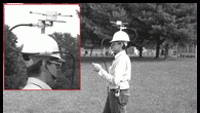If nobody watches, who will notice?

Evaluation of proposed ATSC enhancements to the 8-VSB modulation system have included testing of “walkabout portability,” using the test configuration pictured in the images above; the separate receiver is not shown. Note the wireless phone and headset used for communications between test personnel.
Evolution?
Mr. Birkmaier,
In your March column, entitled Evolution?, you begin a statement on tuner performance with the premise, “Since most consumers will never use the ATSC receiver in new digital televisions, …” If that premise is true, then why (beyond Federal mandate) should broadcasters sink millions of dollars into ATSC broadcasting? Would it not be prudent financially, as well as ecologically, to simply phase out all terrestrial broadcasting in favor of expanding the reach of cable? A basic local service tier could be fully subsidized by the former broadcasters in the market — now strictly content providers — in lieu of capital, maintenance and utility expenditures. Cable would benefit by increasing their penetration to 100 percent, and could then attempt to capitalize on the “foot-in-the-door” to sell non-subsidized tiers and services.
DBS, or IP video via telco-delivered broadband service, could serve the rural areas beyond the reach of cable.
Isn't this the time to gracefully end free, over-the-air video broadcasting? Blame progress. Blame the economy. Blame the government, the regulators, even the consumer.
Why beat a dead horse? If nobody watches, who'll notice? Shut them down like 405 B/W in the UK — if no one complains, then you were right.
Richard A. Pitchford, CSTE, CSRE
Cleveland State University
The professional video industry's #1 source for news, trends and product and tech information. Sign up below.
Craig Birkmaier responds:
Richard,
Clearly, many broadcasters are questioning why they are being forced to invest (potentially) millions of dollars in a digital terrestrial broadcast system (DTTB), for which only a handful of viewers have shown any interest.
The premise upon which I based the statement that most people will never use the soon-to-be-required ATSC tuners in new digital television receivers is quite simple. Like the NTSC service it seeks to replace, the new DTTB service is incapable of delivering a competitive television service reliably to the masses.
You raise the interesting alternative of ending all terrestrial broadcasting services, allowing broadcasters to become “strictly content providers.” I would suggest that this has been mostly true for more than a decade; however, I would rephrase your wording to “content gatekeepers.” The sad truth is that, with the exception of local news and the occasional public service program, broadcasters produce very little content. The economic engine of local broadcasting is the government-supported franchise to act as gatekeepers, providing access to local advertising markets. The economic engine of public broadcasting is our tax dollars and contributions to subsidize the service.
Cable and DBS serve fixed receivers. If this is all that we want in the future then I strongly support your plan. So a more relevant question is, why should local broadcasters exist at all?
The answer is also simple. The broadcast spectrum is fully capable of supporting a competitive and reliable multichannel service; one that can deliver not just television entertainment, but a tidal wave of bits that carry relevant services to local communities. We are an increasingly mobile society, and we expect to be able to access information and entertainment anywhere, anytime. This is an important competitive advantage for DTTB that will become increasingly important in the future and, in my opinion, sufficient justification to allocate spectrum to digital broadcasting.
Cable and DBS ascended to their current dominant position as distributors of television content because the analog broadcast system was incapable of delivering expanded program choice, AND because the broadcast business model remained focused on serving the masses, rather than the market niches. For the most part, the philosophy behind the DTV transition has been to preserve the existing broadcast business model. I will leave it to our readers to decide whether this means preserving NTSC and its attendant regulatory benefits, or migration to a digitized version of the old business model.
The technology exists for broadcasters to re-invent the way in which all forms of digital media content are delivered to the masses, and the niches. Why cede the business to cable and DBS and the “broadcast” networks who care only about controlling local advertising revenues?
January Freezeframe:
Q. A product was introduced in a private suite at the 1994 NAB covention. It may never have been fully successful, but it could be called the first of today's large-scale storage systems. Name the product and the company that introduced it.
A. BTS introduced the Media Pool in a private suite. No one correctly guessed the company and product.
